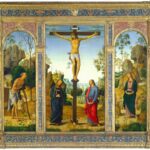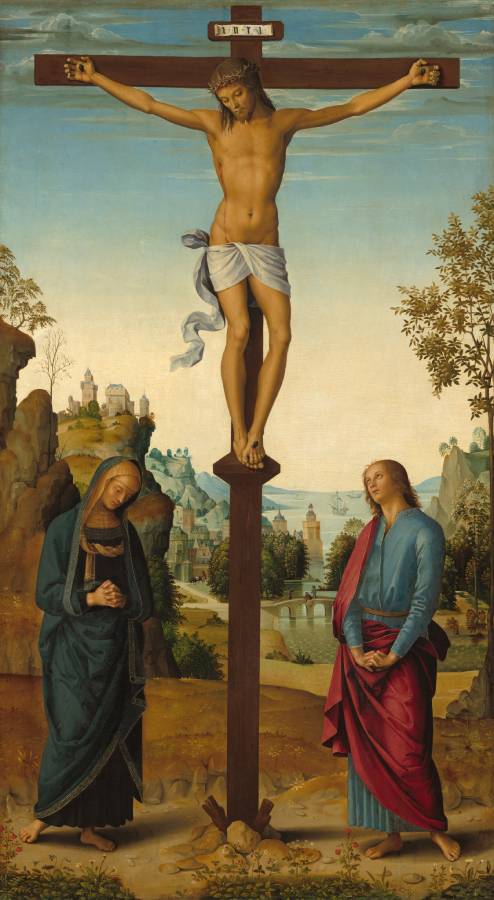Perugino (c.1446-1523)
Crocifissione (Crucifixion)
c.1482–1485
Oil on panel transferred to canvas, 101.5 x 56.5 cm
National Gallery of Art, Washington
Pietro Vannucci, called Perugino after the city in which he often lived, collaborated with other celebrated painters in one of the most prestigious commissions of the late fifteenth century — the decoration of the walls of the Sistine Chapel in 1481–1482. He headed active workshops in Perugia and Florence, where he would eventually be overshadowed by his greatest pupil, Raphael. Perugino‘s Crucifixion with Saints, painted for a chapel in the Dominican church in San Gimignano near Siena, shows Christ hanging on the cross with Mary and Saint John the Evangelist at his feet. In the two side panels, Saint Jerome with his lion, and Mary Magdalene gaze up at the figure of Christ. However, the work does not attempt to depict the actual event or place, but is a visual meditation on the theme of the Crucifixion. The serene mood is reflected in the landscape, which also reveals the influence of Flemish painting which had recently been introduced into Florence. From the late seventeenth to the early twentieth century Perugino‘s Crucifixion was thought to be the work of his pupil Raphael. When it was discovered that the donor of the triptych died in 1497, when Raphael would have been only fourteen, Perugino‘s authorship once again became clear. A man hangs from a wooden cross at the top center of this vertical painting, with a woman standing at the foot of the cross to our left and a man to our right, all in front of a deep landscape with mountains along a river. All the people have light skin. The feet of the man on the cross, Jesus, line up with the tops of the heads of the people standing below. Jesus hangs by a nail driven through each palm, and his overlapping feet are nailed into a short platform that angles downward. He has shoulder-length brown hair and a short brown beard. His head tips forward, and his eyes are downcast or closed. He has a straight nose, high cheekbones, and his lips are closed. Blood trickles down his forehead from a ring of thorns around his head, from the nails in his hands and feet, and from a short gash over his right ribs, on our left. A white loincloth is wrapped around his hips, and the end of it flutters as if in a breeze to our left. The man’s body is lean but muscular. A slip of paper with the letters “INRI” has been affixed to a small panel on the cross above Jesus’s head. Below and to our left of the cross, a woman stands with her head bowed, looking down with her hands clasped in prayer. Her hair is covered with a tan-colored veil and she wears a gold-edged, navy-blue robe that covers her head and body. She and the cleanshaven, blond man standing to our right of the cross both have bare feet. The man looks up at the cross with his lips parted. His fingers are intertwined and then flipped, palms-down, with his arms straight. His raspberry pink-robe falls over one shoulder and around his hips, over a topaz-blue, ankle-length tunic. The dirt-packed ground on which they stand is lined along the bottom edge of the panel with plants and flowers. The golden-brown land dips beyond the people, leading down to a river that winds into the distance. A castle-like structure perches on cliff-like outcroppings high along the left edge of the painting, and buildings at the foot of that outcropping line the river. Two people walk and one person fishes off a bridge near the town. A few boats, one with full sails unfurled and another possibly with oars out to row, float in the river beyond, which is flanked in the deep distance by mountains painted blue in the haze. The horizon comes about halfway up the composition, crossing the painting just beneath Jesus’s feet. The sky above deepens from pale yellow along the horizon to robin’s egg blue where a few wispy clouds create streaks along the top edge. (NGA)
This painting is the central panel of the Galitzin Triptych.
See also:
 Perugino (c.1446-1523)
Perugino (c.1446-1523)
Trittico Galitzin
c.1482–1485
National Gallery of Art, Washington
